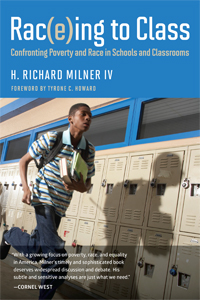Rac(e)ing to Class: Confronting Poverty and Race in Schools and Classrooms
H. Richard Milner IV Harvard Education Press, 2015, 212 pp. Principal, January/February 2016
 H. Richard Milner IV
H. Richard Milner IV
Harvard Education Press, 2015, 212 pp.
Principal, January/February 2016
Race and poverty are widely held to be among the most impactful factors in public schools across the country. H. Richard Milner IV uses his new text, Rac(e) ing to Class, to promote his mission of helping districts to consistently pursue principles and practices that can make a difference. He encourages decision-makers to “work towards those principles even if they are not able to completely implement them.”
Milner’s book will appeal to education leaders concerned with the effects of race and poverty in the classroom. It advocates for district leaders to practice equitable decision- making, respond to neighborhood conditions, reduce class size for school-dependent students, and rethink/reform the inflexible, narrowed curriculum.
Within the text, Milner offers specific, research-based steps to reduce the effect of race and poverty in classrooms. He presents case studies so readers can compare their situations to those faced by other schools across the nation. Milner provides both quantitative and qualitative data to support his ideas, while advocating throughout for the child and teacher. According to Milner, while an individual teacher can make a difference, meeting the needs of students due to challenges from race and poverty will take system-wide reform, and districtwide structures and policies will have the greatest impact in student achievement.
Milner offers a call to action and renewed sense of urgency by advocating for better teacher education to support educators’ abilities to fight the effects of poverty and racism on student learning. He recommends that macro- and micro-level policies be examined for barriers to teachers growing their knowledge base about race and poverty education. He also offers short- and long-term steps for the professional learning community of teachers to recognize the effect of race and poverty on the classroom.
As a school principal, I found that Milner’s text challenged some of my own thinking, validated some of my own practices, and offered me ideas for addressing the needs of all students on my campus. He writes with a true passion for the topic, while connecting his research and the research of others to make his point. The book is a manageable read at 212 pages and provides many thought provoking opportunities throughout.
Reviewed by Kristin Liewehr Bishop, an elementary school principal in Plano, Texas.
Copyright © National Association of Elementary School Principals. No part of the articles in NAESP magazines, newsletters, or website may be reproduced in any medium without the permission of the National Association of Elementary School Principals. For more information, view NAESP’s reprint policy.

